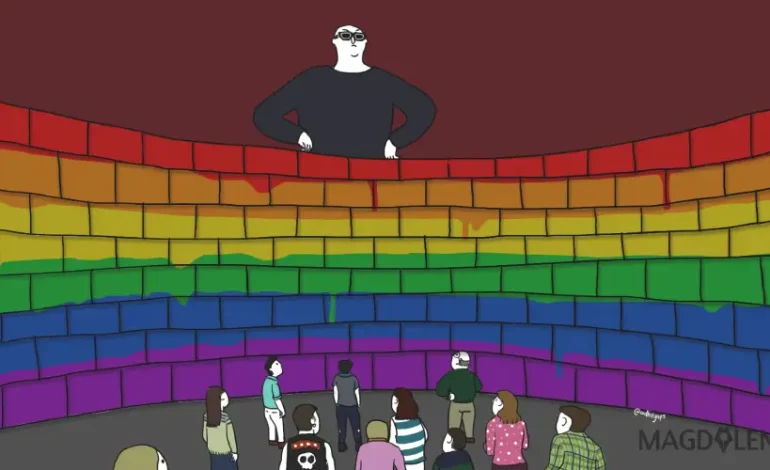LGBT+ History: How Theatre Gave Voice to a Queer Holocaust Survivor

Many Holocaust plays feature Jewish teenagers coming of age in the shadow of the death camps. Yet these works often present sentimentalized, redemptive stories, such as the 1950s production of The Diary of Anne Frank. They foreground certain narratives to the exclusion of others, such as queer experiences. Speaking testimony, however, can bring such stories back into the present.
How might we use the stage to tell a different story about the Holocaust to young adults? This was the conversation with which we – Anna Hájková, a Holocaust historian, and Erika Hughes, a scholar and director of Holocaust theatre – began our project. We chose to focus on the marginalised topic of the queer coming-of-age experience because it offered a powerful counterpoint to the usual stories of the Holocaust.
Using the tools of documentary theatre, we presented one woman’s account of queer desire and survival in ghettos and concentration camps, centering a non-stereotypical perspective of life in the Holocaust. We invited audiences to abandon their preconceptions of young people’s stories from the camps.
The story we tell defies the standard assumptions that have shaped so many representations of the Holocaust. Our starting point was the life story of Margot Heuman, the first lesbian Jewish Holocaust survivor who bore testimony. Still thriving at 94, Margot lives in the US.
Over several months we developed a one-act play, The Amazing Life of Margot Heuman, which premiered online at the UK’s Brighton Fringe Festival during lockdown in 2021, and will be shown in Canada, the US, and Germany later this year.
Margot Heuman’s life story presents a familiar Holocaust story in some ways, but confounds expectations in others. Born in 1928 in Germany, Margot grew up in a middle-class family in Bielefeld. In 1943, they were all deported to Theresienstadt ghetto. As a little girl, Margot knew she was attracted to women. In Theresienstadt, she experienced some happiness thanks to relative normality of life in a youth care centre in the ghetto.
Also Read: Religious Trauma Drives Me, A Queer Girl, Away from God
It was in this children’s home that Margot met Emma, a Viennese girl – “the love of her life”. Both were deported to Auschwitz, Neuengamme and eventually to Bergen-Belsen, where they were liberated by the British army. Throughout the hunger, cold, forced labour and separation from Margot’s family, the relationship sustained both teenagers.
For decades Margot bore testimony about her imprisonment, but never discussed the actual meaning of her relationship with Emma. One of us (Anna, whose work addresses queer experiences of the Holocaust), met Margot and interviewed her many times. It was only with an openly lesbian historian, specifically interested in queerness, that Margot shared her whole story.
A Whole Life in an Hour
Working through hours of oral testimony given by Margot to Anna, we devised the script and staged the play as a work of documentary theater. This process revealed much about the tensions between written history and dramatic composition. While the words came directly from the interview transcripts, the decision of what to include – and more importantly, what not – took weeks of editing and workshopping.
How could we condense the story of one amazing life into a one-act play, lasting less than one hour? There were so many details that did not make it to the stage – not because they weren’t vitally important, but because we needed to be concise.
The Amazing Life of Margot Heuman offers a meditation on bearing testimony, on first love and on making space for queer romance in otherwise homophobic surroundings – often when the stakes are life and death.
Also Read: Had I Known, I Would Never Have Accepted the Role of a Token Gay Friend
There are only two characters in the play: the survivor Margot and the historian Anna. In staging the performance as a conversation between survivor and historian, we illustrate how Margot’s act of witnessing is also yielding control over her story to the historian. Her insistence on agency is an insistence on dignity.
We also wanted to render the role of the historian transparent, revealing Anna’s reactions to Margot’s testimony to show how the historian shapes it into historical narrative.
We didn’t want the kind of theatrical realism that might give way to sentimentalisation, which can sometimes obscure historical fact. To that end, Erika, as director, had the performers carry their scripts throughout, often turning to them to read dialogue, as a reminder of the testimony from which their words came.
The part of Anna the historian is read by an actor of her age. Though Margot is now in her nineties, her words are spoken by an actor in her early twenties – not much older than Margot was herself was during the Holocaust.
At the beginning, the performers break the fourth wall, addressing the audience directly and introducing themselves by their actual names. With these techniques we forged a critical distance between the performance and Margot’s actual experience, encouraging audiences to reflect on Margot’s life as a lesbian woman during the Holocaust and after, in the US. Onstage, Margot and Anna bond over their shared experiences, but the play invites audiences to see how there remains a historical and generational chasm between the two.
The play illustrates Margot’s story with real images from her archive, including old photographs of her as a young girl and documents of her journey in concentration camps during the Holocaust and displaced person camps after the war.
In the end, as the historian Anna tries to piece together a narrative from the physical pieces of the archive, Margot ultimately asserts her agency over the space – rearranging the pieces to tell her own story. It is her voice that remains front and centre.
“I was amazing,” she rightly says, to history and the present.
This article was first published on The Conversation, a global media resource that provides cutting edge ideas and people who know what they are talking about.






















